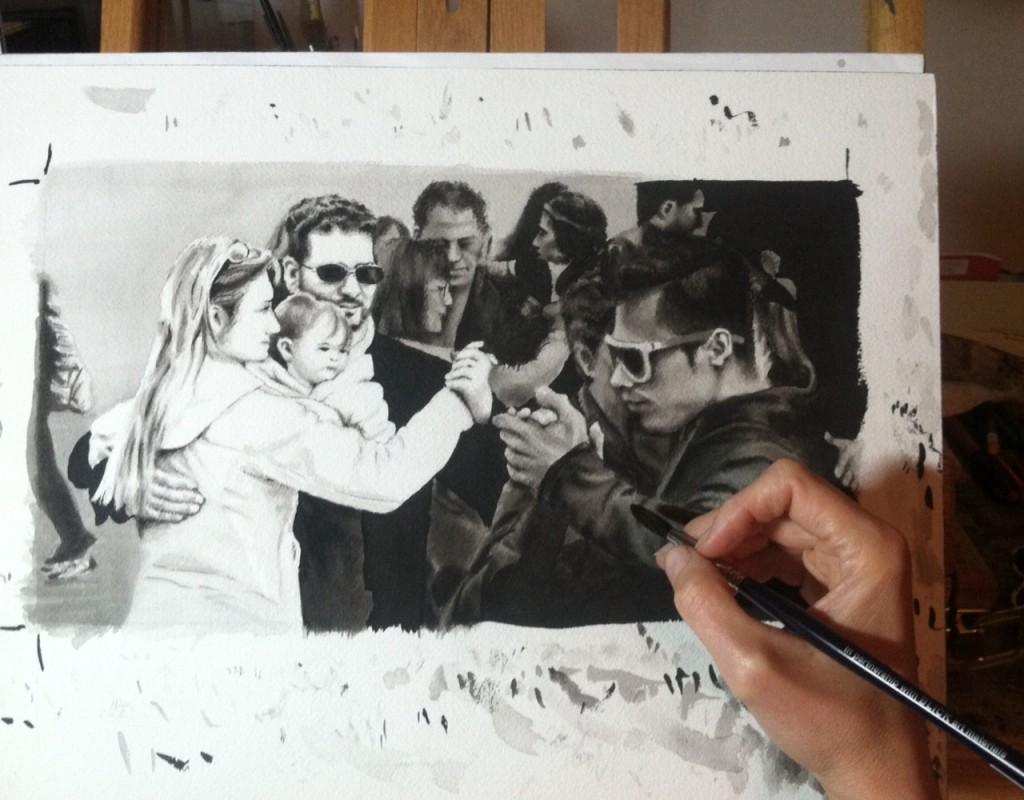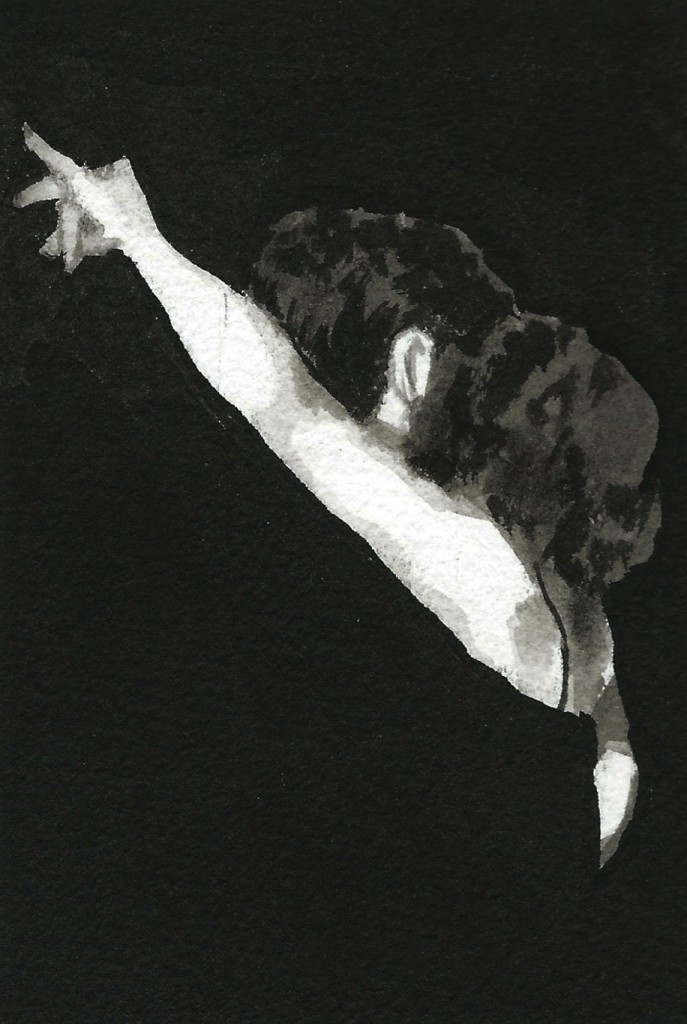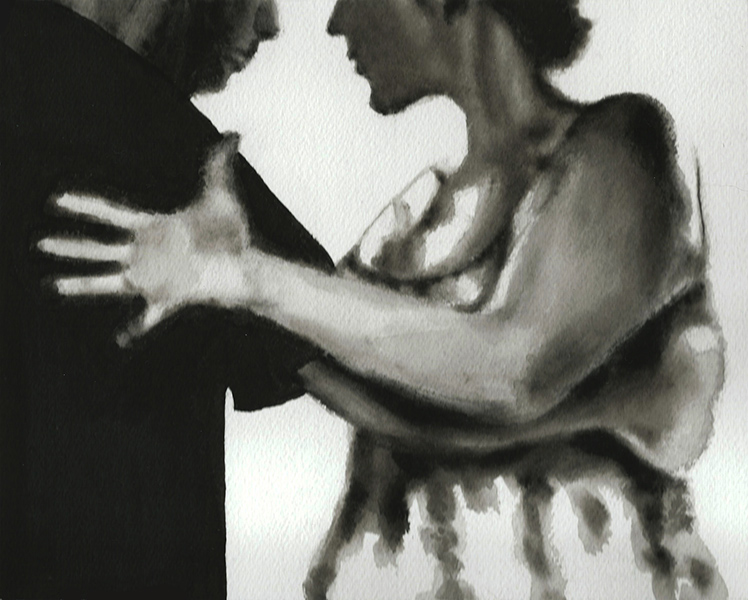When I first saw Jordana’s Tango art from a distance, I could have sworn they were black and white photographs.
Upon closer inspection I discovered they were paintings. She is that good. Since she paints with India Ink (a black ink that can be watered down) her work has a soft flowing feel to it, almost as if the dancers are really moving; a moment caught in time. Her subjects are our local dancers, often immediately recognizable, sometimes not. She says some of the best ones can’t be shown publicly, for various reasons. Knowing that, how can one not be intrigued to see them?
Jordana del Feld is a trained artist with an MFA from NYU. She studied watercolour and figure drawing in the Beaux-Arts style in the New York atelier of Christopher Young. She continued her art education at Parsons School of Design and the San Francisco Art Institute. You can find her work is in private collections and has exhibited with the San Francisco Women Artists’ Gallery and the Studio Gallery.
Jordana is not just an artist, she is also a dancer and a writer (and many other titles). Perhaps because of this, she understands what it feels like to be a subject of her work. She uses her own experiences to capture the magical moments that happens between people in Tango.
Being a fan of her tango paintings, I asked her for an interview to learn more about the inner workings of this dynamic tanguera/artist. As you will see, her answers proved aptly captivating.

SF Loves Tango: What brought you to Tango and what does tango mean to you?
Jordana: I have no idea. I generally act in order to learn, instead of the other way around. So I’ll let you know in fifty years. I also love a challenge. A ballet dancer friend once said “Argentine tango is the most difficult dance in the world!” So although I had never seen tango, I thought, “cool. Some day I’m going to do that.” I used to do a lot of martial arts. But I didn’t want to get my nose broken, so I stopped. I also used to do a lot of swing and ballroom, but didn’t find them intellectually demanding enough. Fifteen years after the ballet dancer’s remark, I saw a demonstration of ordinary social tango at the symphony, and it clicked. Here was the perfect blend. Finally, something that would never stop blowing my mind. I didn’t know at the time that it would hurt a lot more than karate…but that just makes it more of a challenge.
What does tango mean to me? I like the “tán-go: to hear and be heard” t-shirt. But whenever I say “it’s this,” I’m neither wrong nor right. I usually say, “it’s a lens through which we view life.” Or, “it’s yoga for two.” Or, “there are many paths but only one way, and this is one path.” Not wrong. But the act of saying them misses the point. Maybe I should add, “it’s what you can’t verbalize.” I like other people’s “wrong” answers because they teach me what I think. Someone said, it’s a challenge to be elegantly passionate. But for me, a choice to emphasize elegance and passion creates artificial boundaries: if I tell the dance what I think it should be, I don’t allow it to be what it is. Someone else said, “it’s a social dance!” With which I disagree so much that I’ve now come full circle and agree, in all its disturbingly minimalist glory.
SF Loves Tango: What inspired you to start drawing tango?
Jordana: I like subjects with compelling narratives, dynamic composition, complexity, and simplicity. And I’ve always loved English murder mysteries. I’m driven to solve puzzles, secrets fascinate me, the seething amoral intensity of human nature is mesmerizing, and how we try to package all that up into something socially acceptable is brain fodder for a lifetime. I love the contrast between homo and sapiens, the balance between rational and irrational. I love thinking I know what’s going on and then realizing I have no idea at all. Sometimes I question my ethics in painting tango. It is, after all, none of my business. The public intimacy of tango never stops confusing me—not the perceived intimacy of a flashy leg wrap, but the invisible moments that happen between two people, that are just for them and nobody else. It would be better to avert my eyes. But then I tell myself, we all agreed upon a social pact by showing up, that we could all see and be seen. It’s like eating garlic: if everybody’s doing it, then it’s okay. And when I see that beautiful moment, it bugs me and bugs me and I must draw it.
SF Loves Tango: What technique do you use to create your work?
Jordana: I video dancers with my phone, which is the hardest part of the process. The best moments usually happen in places where it’s too dark for a camera to see. Sometimes I try anyway, and then have to decipher red and black blurs that feel like they’re about one pixel per square inch. I go through the clips frame by frame to find the right moment. I use the stills as references to freehand sketch all my pictures. No tracing. I make a very precise pencil outline on watercolour paper. You can’t erase over ink, so getting the foundation drawing exactly right is the highest stakes part of the process. Then I paint the grisaille, using a brush with full-strength permanent India ink in my right hand and a brush with plain water in my left hand. India ink is great because it has a strong black and dries instantly. On the other hand, it has a strong black and dries instantly—so the pressure’s on! Once you make a mistake, it’s there forever and everyone will see it, because covering up marks with white paint doesn’t work. Ink also leaves hard edges around its brush strokes, which is great when you want a sharp outline, and horrible when you want to draw something soft, like skin or hair. I handle soft areas and shadows by dropping ink into water on the area in question.
SF Loves Tango: What are people’s reactions to recognizing themselves in your work?
Jordana: Can I talk about people’s reactions to recognizing their friends and lovers instead? Because that’s universally positive. Ohmygosh, that’s amazing, so beautiful, looks just like them, I want one, etc. Most people recognize their friends with mind-blowing speed—even if the pictured friend is barely visible or defined—and they get excited. It’s like knowing someone with a Wikipedia entry. But when it’s themselves in the picture, the first thing people usually remark on is some aspect of themselves they feel insecure about. Painting people is extremely delicate social balance, especially for me, because I have no imagination. I see what I see and have difficulty pretending otherwise. I love all my subjects exactly the way they are in that moment, otherwise I wouldn’t paint them, and I think nothing is as beautiful as the truth. If it’s true, then it’s beautiful. If I make it up, it’s worthless. I don’t paint moments of bad technique. Dancers are beautiful people. I wish they would see themselves with as much love as I do!
 Sometimes people are happy and proud. Sometimes their smiling faces tell me they feel like they have to complain for form’s sake, to look modest, but inside they’re thrilled. A few visiting pros have seen my dancers on walls and protested, “hey, where’s my picture?” All in good time, guys…. Sometimes people are unnerved, like I’ve not only seen them naked, but shown their secret
Sometimes people are happy and proud. Sometimes their smiling faces tell me they feel like they have to complain for form’s sake, to look modest, but inside they’re thrilled. A few visiting pros have seen my dancers on walls and protested, “hey, where’s my picture?” All in good time, guys…. Sometimes people are unnerved, like I’ve not only seen them naked, but shown their secret
nakedness back to themselves. That thing they were hoping nobody would notice. And sometimes, they notice nothing at all! I can feel like I’m yelling secrets from the top of the town bell-tower and nobody notices anything! It’s just like a milonga. People like to commemorate and share times when they were happy. In that way, my pictures act like glorified selfies. “Hey, there’s me, dancing with that guy/chick! I enjoyed that dance, I like that person, and man, we look great together!” I think they also find validation in being witnessed and recorded. That thing I thought I felt really happened. See, here’s a picture of it.
SF Loves Tango: Do you solicit commissions?
Jordana: I love commissions! Commission me! What could be nicer than a picture of yourself and/or somebody you care about, doing something you love? Let me capture your moment.
SF Loves Tango: Where can people see more of your paintings?
Jordana: They’re currently for sale at la Pista, 768 Brannan, SF; Studio 1924, 1924 Franklin, Oakland; and Keiko’s dance studio at the Kabuki Salon, 771 Bush, SF. And on my site, jordanadelfeld.com.
Thank you Jordana!
